RC Sailboats
An overview of radio controlled sail boats and a brief explanation of scale model sailboats, semi scale rc sport, and rc racing sailing yachts. kits, rtr and scratch built..
RC sailboats can be divided up in three main categories:
- RC Sport Sail
- RC Sailing Yachts (for racing)
- RC Scale Sail

RC sport sail
Most kits and RTR (ready-to-run) model RC sail boats are best categorized as RC sport scale. This category is a happy medium between full-blown scale models and RC racing yachts.
Some have become so widely distributed that new racing classes has been formed around them. Good examples are Graupner's Micro Magic and Kyosho's Fairwind.
They are usually semi-scale of modern cruising yachts or made to resemble America’s cup sailboats.
The lower cost models come with ABS hulls, whereas the higher end models come with more durable fiberglass hulls. Drop keels, aluminum masts and Dacron sails are most common.
RC racing yachts
If you want to get into RC yacht racing there are a number of classes to choose from. Each country has a governing body ( American Model Yachting Association (AMYA) in the USA, Model Yachting Association in the UK) under the International Model Yacht Racing Union.
As with full size regattas, RC model yacht racing face some of the same issues. Entry rules for competitions typically follow depending on if the class is Open or Closed Design.
Open or Construction Class
What these classes have in common is that the boats are not identical - instead the rules are made up like a mathematical formula. The good thing that brings is that the challenge is three-fold – design, construction and sailing the course.
The disadvantage is in that the rules for some classes can be complicated. Some classes have gained in popularity precisely because the rules fro previously established classes were so hard to understand.
Examples of some popular open design model yacht classes:
- 6 Metre - M6R
- 10 rater – R10r
- 36" (36-inch)
Closed Design or One-design Class
All entries have to be the same design. Some are kits from a single manufacturer others are open to home built model boats.
- Soling 1 Meter
- Micro Magic - Graupner
- Fairwind - Kyosho
RC scale sail
We're talking about scale model sail boats that actually use its sails as the main means of propulsion. RC scale sail is called minisail in continental Europe. The vast majority of sailing scale model boats is scratch built. There are a few kits - Billings Collin Archer RS-1 comes to mind.
The prevailing problem with scaling a sailboat is that stability doesn’t scale linearly with size. The result is that model boats will always be significantly less stable than the boat or ship it was modeled after. Left as is, it may have detrimental effects on the model’s sea keeping abilities. There are ways to minimize the effect.
A smallish boat built to a large scale is more stable than a large ship to a small scale. For instance, say you can only transport a model 1m long. Building a model of an 8m cruising yacht at 1:8 scale will be more stable than a model of the USS Constitution at 1:48 scale. This is true even if they end up weighing the same and being the same length. I bet the yacht will be a much better sailer too.
Bigger is always better too, when it comes to scale RC sailboats. Try and build the biggest model you can get away with. A larger model will be more forgiving on construction techniques, materials and the weight of components. The finished model will also be faster, a better sailer and handle stronger winds than if it was built smaller.
Making considerable effort to build light is always a god habit. The higher up a part or component is located, the more important this becomes. For instance, rigging components need to be light weight.
Other factors are beam and draft (width and depth for landlubbers). A wider and deeper hull will naturally be more stable than thin and shallow.
There are two tricks to increase the stability of model boats artificially:
Add a drop keel
By adding a drop keel you can bring the center of gravity down while adding profile area. The greater under-water profile helps against drifting sideways. All sailboats drift downwind some, because the surface water moves with the wind. The lower boundary-layers of a body of water are influenced less by the wind than layers closer to the surface. Therefore, the deeper any extension of the hull is, the less drift.
Typically a boat with a drop-keel also needs a larger rudder. A good guideline is to make the rudder area 10-12% of the total submerged hull profile.
Extent the hull below the waterline
Some builders rather build the boat hull slightly out of scale than add a drop keel. The most bang-for-the-buck is to deepen the hull. Same rule apply about the rudder (rudder area = 10-12% of total submerged profile). You could technically make the hull wider, but the effect is not as great.
Any change in the submerged hull profile need to maintain the same geometric center to balance the center of effort on the sails. Naturally, if you know what you are doing, the sail and rig can be modified also.
A Final Word on Scale RC Sailboats
Generally stay away from lateen rigs, multi-hull, centerboard designs and square riggers, at least until you have become an experienced RC sailboats captain and/or builder.
Return from RC Sailboats to Radio Controlled Boats
Return to Homepage
| Facebook Twitter |
Would you prefer to share this page with others by linking to it?
- Click on the HTML link code below.
- Copy and paste it, adding a note of your own, into your blog, a Web page, forums, a blog comment, your Facebook account, or anywhere that someone would find this page valuable.
- Plans Store
- Model Boat Books
- Model Boats Intro
- Building Materials
- Make a Hull
- Plastic Kits
Radio Control
- US Battleships
- Torpedo Boats
- Model Boats Q&A
- Model Ship Gallery
- What's New?
- Privacy Policy

By Petter Blix
Copyright 2009-2018 Building-Model-Boats.com
Trademarks belong to their respective owners
All Rights Reserved
BoatNews.com
Free model boat plans: the MiniX, an easy-to-build radio-controlled sailboat
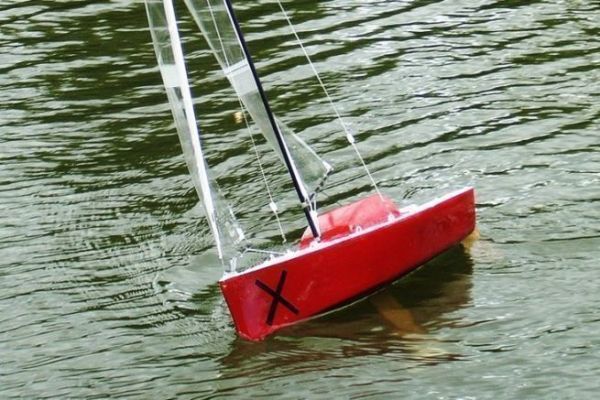
We set ourselves a challenge: to make a sailing model. In the end, after hours of reflection and work, we discovered that we took as much pleasure in designing and building as we did sailing our yachts. Here is the description of our project and the plans to download. Another article follows with the steps of the realization.
An easy-to-build, eye-catching, high-performance sailboat
Who hasn't dreamed of a little wooden sailboat with a beautiful canvas cover? The idea for this project is a child's dream.
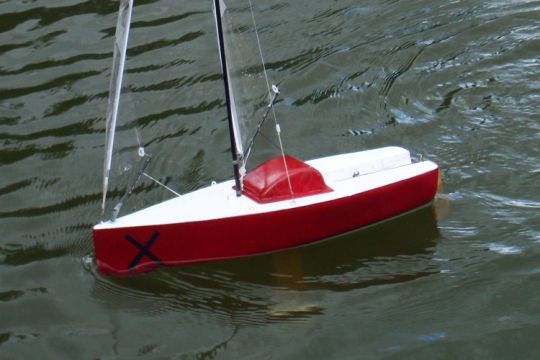
Sailing on a regular basis in "scale 1", we had the idea of having fun by sailing two boats to race in our "spare time". The boats had to meet the following specifications:
- Easy to transport. Measuring just 50 cm, our MiniX doesn't take up much space in a trunk. However, the keel and mast can be dismantled. If need be, the MiniX can even be included in our vacation luggage.
- Able to be thrown into the water "out the back of the car" without complicated implementation.
- No investment that would jeopardize our homes. As this is not a one-off activity, we didn't want to invest in expensive radio controls (our boat's biggest expense). A basic radio control kit is powerful enough to handle "small" sail surfaces.
- Resembling a sailboat at best, hence the presence of the deckhouse and cockpit. These two elements give a sense of scale without resorting to model-building. Above all, a sailboat must be beautiful. Don't we also sail for the pleasure of our eyes?
Modern construction
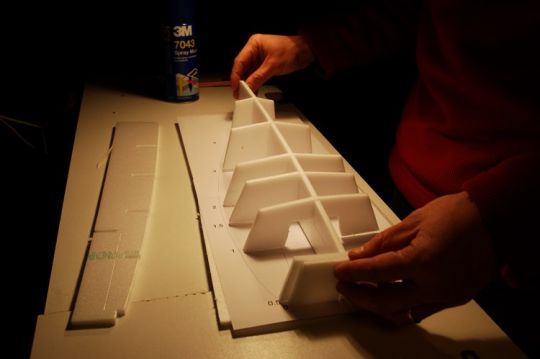
To keep it light (ready to sail , the MiniX weighs just 800 g), the hull is an extruded polystyrene/epoxy resin sandwich (laminated Depron). While this process is not impact-resistant (though...), the structure and sandwich make it very rigid. Together with the deck, the whole thing forms a kind of egg whose strength is astonishing. It's impossible to apply the slightest twist to the hull, despite its lightness (the bare hull weighs just 260 g).
Our yacht has a chine hull. But this doesn't detract from the look, as the chines are largely rounded and, combined with the straight bow, give the illusion of a beautifully shaped hull. When sailing close-hauled, the stern of the MiniX lifts off, limiting drag in the water.
Technical data
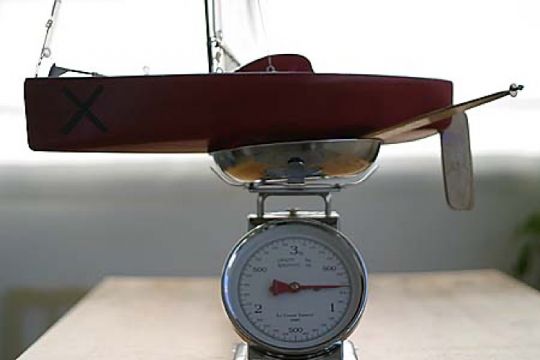
- Overall length (with rudder): 56 cm
- Hull length: 51 cm
- Width: 17.6 cm
- Draft: 25 cm (but this may change...)
- Air draft: 92 cm (mast: 86 cm)
- Operating weight (with sails, servos, batteries and keel ): 800 g
- Bare hull weight (without servos and keel ): 260 g
- Weight of ballast: 240 g (but may vary according to draught...)
- Wing surfaces: Jib= 6 dm² GV= 15 dm²
MiniX drawings
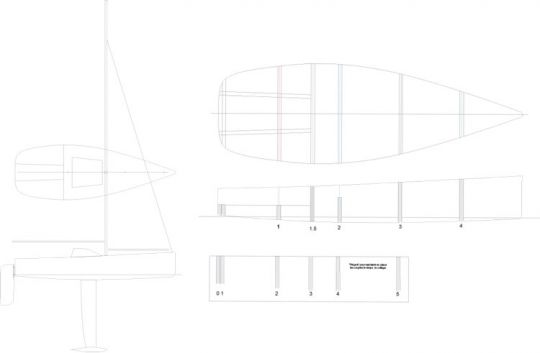
You can download the plans. They're simple and precise. We made our two boats by printing them on a basic A4 printer. Then we simply assembled the sheets by superimposing them and gluing them (repositionable spray glue) to Depron. A sharp cutter is all it takes to build the MiniX with precision.
Just one thing: we've put a lot of heart and soul into building this yacht. We'd be delighted if our experience could be put to good use. Don't hesitate, help yourself! But be so kind as to let us know with a little comment. We'd love to hear from you.
Here you can download the first part of the plan in A4 PDF format .
With this you already have the complete boat. Based on the construction photos, there's not much missing to build the whole MiniX. But since we're taking care of you, here are the sail plans too:
- Mainsail plan
Real sails with webs for their shape.
The construction budget
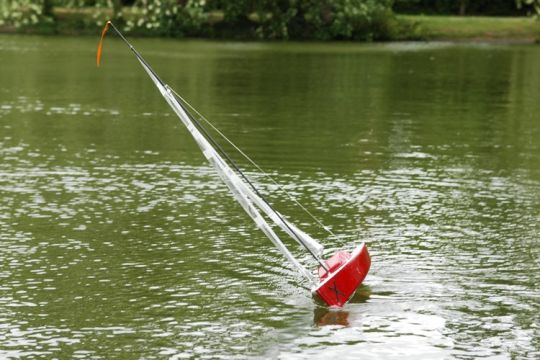
MiniX doesn't have to be expensive. We've always tried to find a way of "diverting" objects to make our project a reality. So it's hard to come up with an exact budget. It will be higher for someone who doesn't even own the basic tools , and much lower for someone who does it in the back of his already well-stocked workshop.
- 6 mm Depron sheet (2 sheets, 125 x 60 cm)
- Epoxy resin + fillers
- Glass fabric
- 4 mm plywood (a small piece for the keel , keel shaft and rudder)
- Carbon tubes (6 mm for the mast and 4 mm for the booms)
- GV carbon batten (1/10 mm in kite stores)
- Remote control servos kit ( first price: ?60)
- Florist paper for the sails (a good opportunity to give pleasure...)
- Blenderm (surgical tape), available from chemists, to join the sails. Cut the 20 mm roll in half to double its length.
In the end, we estimate a maximum budget of ?120 per boat (calculated in 2021).

Because a construction project like MiniX is above all a team project... And in a team it's good to be complementary.
The MiniX project went through a long phase of gestation - reflection - intellectualization - drawings - exchanges - helping hands to get to this stage. Today, it's sailing thanks to this pooling of skills. We hope you'll enjoy this project as much as we have. And we look forward to hearing from you in the comments or on the forum. Enjoy!
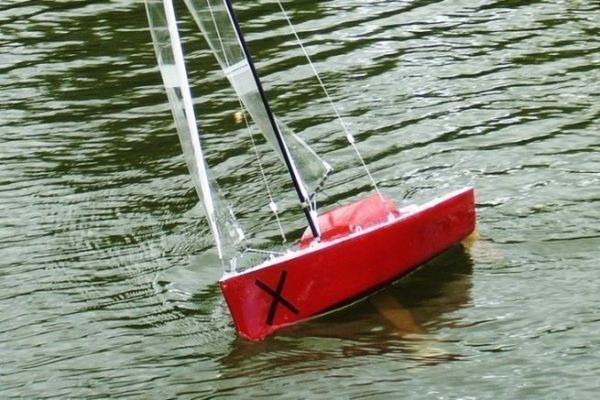

How to Sail an RC Sailboat – Step by Step Instructions – 5 Minute Read
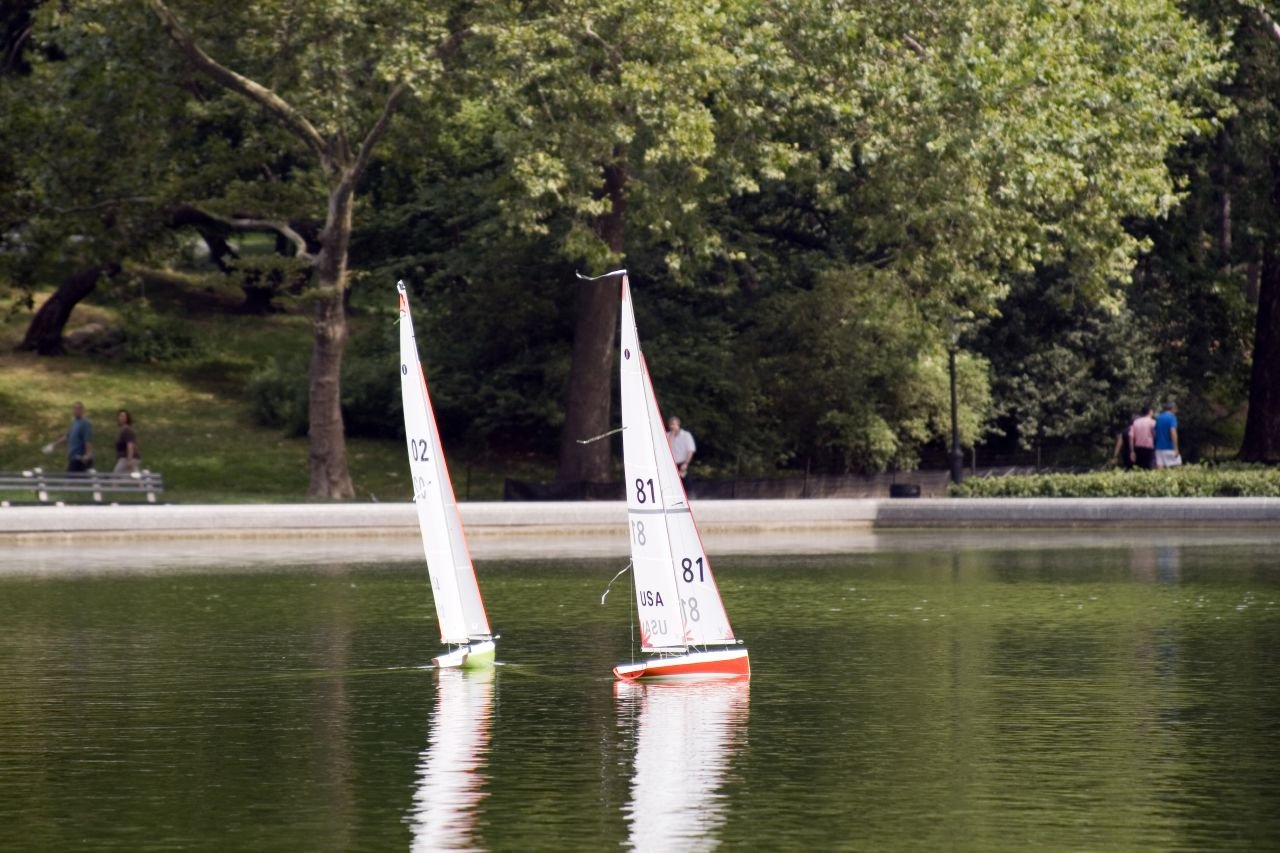
Affiliate Disclaimer
As an affiliate, we may earn a commission from qualifying purchases. We get commissions for purchases made through links on this website from Amazon, the Ebay Partner Network (EPN) and other third parties.
Sailing an RC sailboat is fun, but it takes some practice before you get good at it. I certainly needed it when I started! If you want to take your interest in RC model boats to another level, then you should consider learning how to sail an RC sailboat.
However, learning how to sail RC sailboats requires patience and perseverance. There are several things that you need to master before you can begin sailing. This article will teach you how to sail a radio-controlled sailboat.
Read on below to discover tips that will avoid failure in learning how to sail model sailboats, that apply to all size boats.
Step by step Instructions
How does a yacht sail, how are the sails and rudder of an rc sailboat moved, moving forward in a straight line, sailing into the wind, sailing away from the wind, final thoughts.
First, here’s a summary step by step approach to learning how to sail an RC sailboat:
- Consider joining a local club ( USA UK ) where you’ll find lots of helpful RC sailors and RC sailing events that will help you learn. You may even be tempted to get into RC sailboat racing.
- In any event, choose a day with a gentle, consistent, light wind, preferably with the wind direction towards you, just in case you lose control of your boat.
- Find a medium-sized lake or pond, and avoid rivers or the sea, where there may be strong undercurrents. A local club will have a safe sailing area. Look out for areas that may have weeds or reeds, or shallows that could strand your boat. Remember to factor in the depth of the keel, which, on most model sailing boats, is significant.
- Check you are able to sail in your chosen area – ie no prohibitions – and keep clear of swimmers, people fishing, full sized boat traffic, and wildlife.
- Avoid days when it’s busy in your sailing area with other modelers until your sailing skills are such that you can feel confident.
- Set up your RC sailboat on its stand, and check the rigging is as it should be according to the boat’s instructions. Ensure you have brought the boat battery pack charger, the batteries are charged, and you have spare AA batteries for transmitter. Turn on the transmitter, and test that the rudder control and sail servos are all working properly.
- Ensure you understand the basics of sailing, set out below, before launching your RC sailboat. Keep a keen eye on how your boat reacts to the wind, and be ready to react in turn by altering the sail angle to maintain the boat speed as far as possible.
The first thing you’ll need to know is how does a yacht sail? An rc sailboat sails just like a full size yacht. The wind energy pushes against the sails and flows over them, creating a difference in wind pressure on each side of the sail, which is translated to forward movement by the keel of the boat. Without the keel, the boat would be pushed in the direction of the wind.
To keep the yacht moving forward, the sail angle to the wind is adjusted depending on the position of the boat. Paradoxically, a sailing boat can sail into the wind, as well as with the wind. The only direction that can’t be sailed is with the wind directly in front.
The direction of the boat is adjusted by the rudder, which is at the back of the boat.
The following diagram shows the sail angles at different points of the wind:
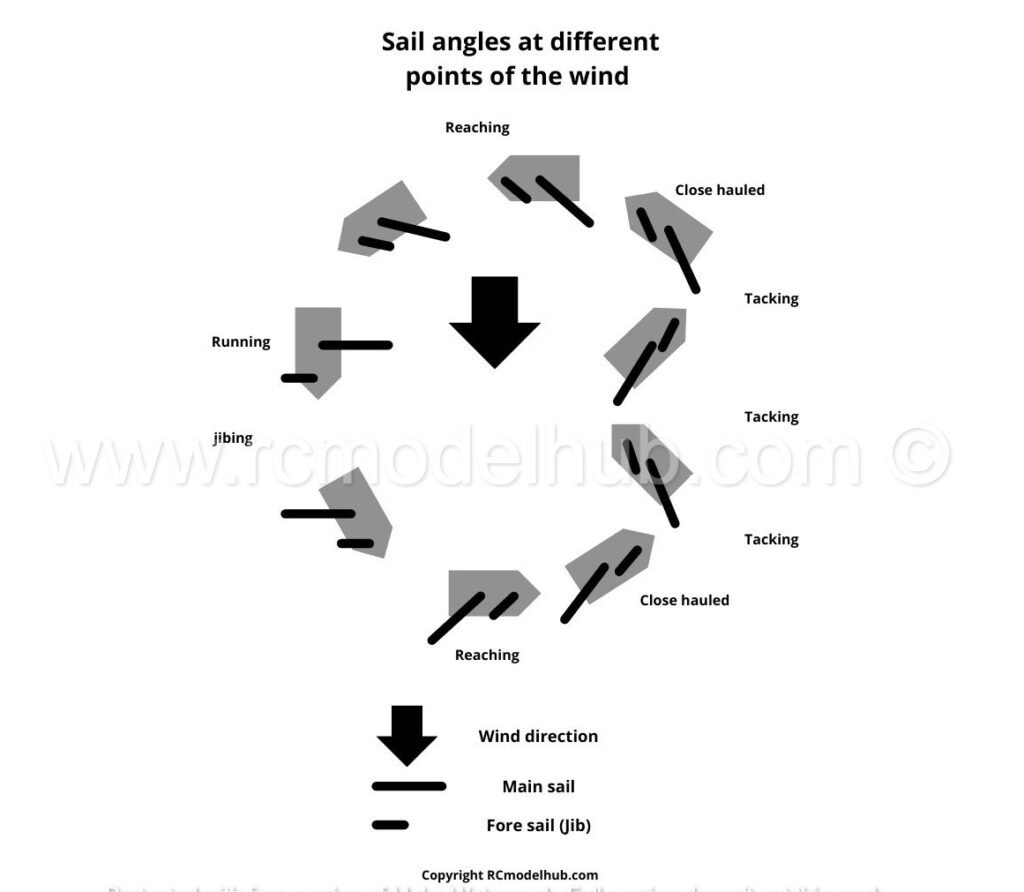
As a beginner RC sailing boat helmsman, many of these terms will be confusing to you, but they will soon become familiar.
The controls of an RC boat are explained in more detail in t his article , but basically, the hull (body) of the boat contains batteries that power servos which in turn move the rudder, the main sail, and the fore sail (the “jib”). The servos are controlled by a receiver, that takes commands from the RC transmitter which you hold in your hand. Here’s a short video that explains the transmitter controls:
How to sail an RC sailing boat
First, the basic skills. With the boat in the water, start with the wind half way between the front (bow) of the boat, and the side (beam). Keeping the rudder straight, trim (move) the sails so that they are close to the hull (close hauled) and the boat should move forward. If the wind is gusty, or very strong, move your transmitter control to let out the sails, spilling the wind, to keep the boat from keeling over.
If you’re sailing into the general wind direction, you’ll need to learn to “tack”, which involves turning the boat from a position where the wind is coming on one side of the bow, through the head-on wind, to end with the wind on its other side. This is achieved by moving the rudder to turn the yacht, whilst changing the angle of the sails to the wind – see the diagram above.
So the boat moves forward via a zig zag course.
As the boat turns into the wind, it slows, so this maneuver should be completed as quickly as possible, otherwise, the boat could get stuck with the sails flapping – this is called being “in irons”.
If the direction you wish to sail in means the wind is behind the boat, it is called running before the wind. In this case, turning the boat involves “jibing”, which is the opposite of tacking.
To change direction whilst running with the wind, move the rudder so the wind goes around the back (stern) of the boat and haul the sails in. As the boat comes round, the wind will move from one side of the sails to the other.
If this is not done smoothly, it could cause the sails to violently move in the opposite direction, possibly causing damage and maybe even capsizing the boat.
So those are the basics of learning how to sail an RC sailboat. As I’ve said above, the best way to refine your skills is to get out on the water and practice.
if you have any interest in remote control sailing but aren’t sure where to begin, use the step-by-step guide above to learn how to sail an RC sailboat. Once you’ve mastered the basics, you can move on to the exciting world of racing sailboats.
If you’re still considering your first RC beginner sailboat, take a look at our article on beginner RC sailboats , or for the more adventurous, consider building your own RC sailboat from a kit. More about that here .
Image credit Nick Kinkaid
About the author
It all started with a line controlled spitfire 50 years ago….
That turned into a life long interest in models, in particular radio controlled models, but I’ve only got back into it since I’ve been retired. As a result a lot has changed, and I’ve been happily starting afresh, researching into the hobby and finding answers to the questions all beginners have when starting out.
I hope you find some answers to the queries you have, and go on to enjoy all aspects of this fascinating hobby.
Latest posts
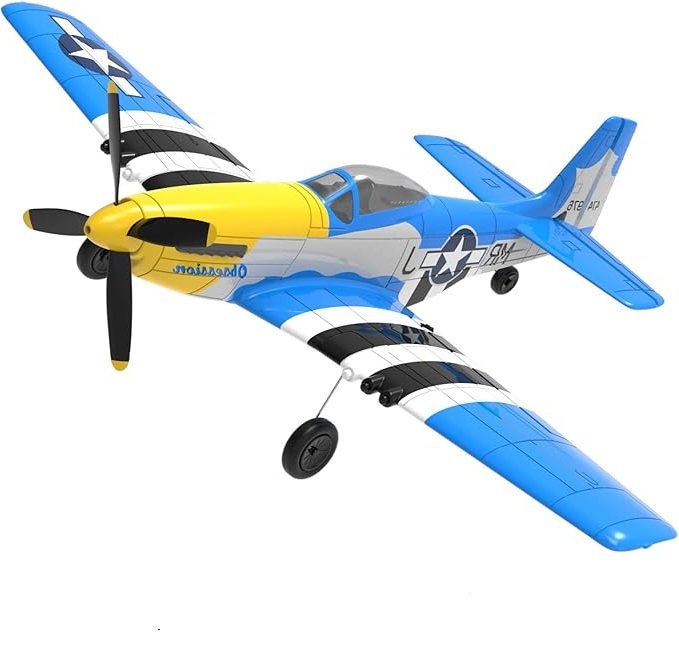
VOLANTEXRC P51 Mustang RC Plane Review: A Beginner’s Dream?
I was thrilled when I discovered the VOLANTEXRC RC Plane. This 4-channel WWII RC Airplane, specifically the P51 Mustang model, is truly a beginner’s dream come true. With its ultra-stable Xpilot gyro stabilizer system and 3-level flight control system, it’s incredibly easy to fly, whether you’re a novice or an experienced flyer. The impressive 2.4…
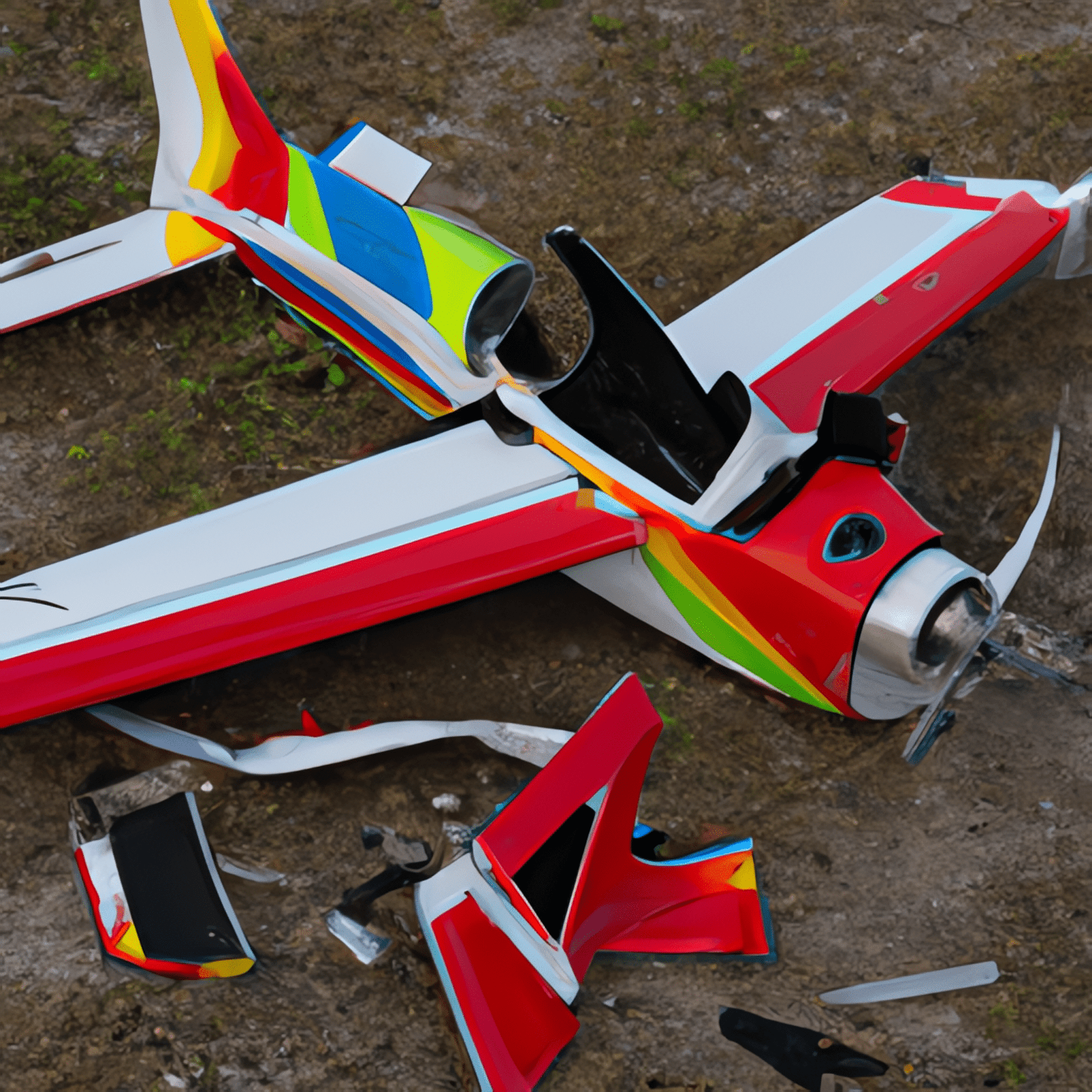
RTF RC planes with SAFE technology: No More Crashes?
RTF RC planes with SAFE technology have revolutionized the world of remote control aviation, offering a new level of ease, control, and safety for both beginners and experienced hobbyists. What a change from my early days of flying RC planes, when you fully expected to come home with your plane in bits! These innovative aircraft…
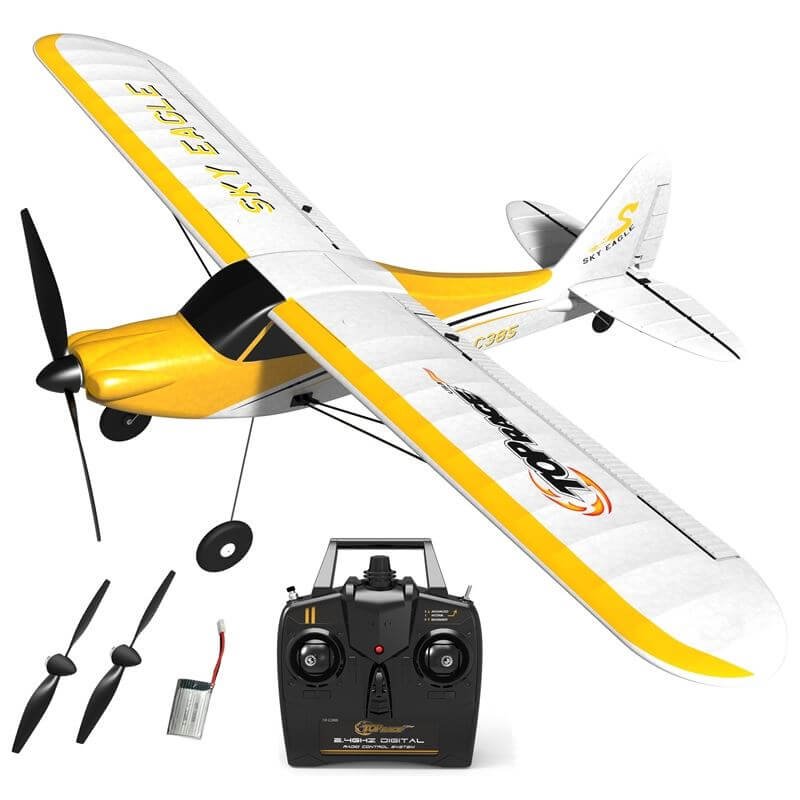
Top Race RC Plane TR-C385 Review: Stunt Flying Delight
I recently had the chance to test out the Top Race 4 Channel RC Plane TR-C385. It surpassed all my expectations. Designed for adults and older kids, this ready-to-fly airplane offers an exhilarating stunt flying experience. With precise control and maneuverability, thanks to its 4-channel system, this RC plane is a great starter or intermediate…

Introduction: RC Boat

How to make an easy and fast RC Boat!
Step 1: The Plans
Here you have the boat plans in .dwg and .pdf format.
Download the .PDF plans if:
- You don´t know how to use AutoCAD yet.
- You don´t have a laser cutting or CNC machine.
Attachments

Step 2: Materials Needed

Build the boat:
- 3 and 5 mm plywood panels.
- Coping saw.
- Sand papers.
- Polyester resin.
- White glue.
- Red, black and white paint.
- Inkjet with white and decal sheets.
Electronics:
- 15kg servo.
- CNC Coupling.
- 200A brushless ESC.
- 115 mm Rudder Shaft.
- HB 3650 Brushless motor.
- 3 channel receiver.
- FS-CT6B transmitter.
Step 3: Cutting the Pieces

- Resize the .PDF as you wish for making a bigger or smaller boat. This model is 900mm long.
Tip: Under 550mm boats built with this plans tend to submerge when the lake is choppy. Be careful!
- Print the pieces in white paper sheets and stick them on the 3mm panel.
- Draw the contour of the pieces with a pencil into the plywood.
- Dettach the papers and cut the panel following the lines you have done before.
Note: Don´t cut Half of Deck pieces until you have read Step 6.
Step 4: Hull Bottom

- Glue the bottom pieces to the transom.
Tip: Sand down the inner parts of the bottom pieces before for creating a strong glued joint.
- When the trasom glue has dried up, put the bow sections together.
Tip: Glue four semi-spheric wooden sticks as bilge keels. They will help the boat going straight at high speeds and rolling less.
Step 5: Hull Sides

- Repeat the Step 3 process with the side pieces.
Notice the extra lenght added to the rear pieces for hiding the rudder.
Step 6: Deck

- Join the Half of Deck paper sheets together with cellophane tape or draw the contour of one piece and later the other one with the same sheet.
- Decide the cockpit size and cut the deck squared gap with a cutter. It may vary depending on the motor and batteries you are going to use.
Tip: Don´t make a big gap. The deck is straight until it reaches the yellow line. Exceeding it may cause problems when fitting the cockpit.
Step 7: Waterproofing the Boat

Polyester resin is a good sealer and adds extra strenght to the structure. Without it boats tend to dissasemble while crashing or after a few days touching the water.
- Mix it with two catalyst drops in a can. Pour it inside the boat and spread it over all surfaces and joints.
Step 8: Motor and Rudder Mount

- Attach the rudder shaft to the transom with four screws.
- Cut another 5mm piece. The servo support must have four drilled holes.
- Cable ties are a simple way of making a servo keep its place. Pass them through the holes.
Tip: Install a rubber bellow enclosing the servo bar. Avoid water to seep in!
- Make a 5mm plywood motor mount. We are using the HB 3650 Brushless Motor.
- Align the motor with the 4mm propeller axis and glue the mount to the bottom pieces.
Tip: Seal the axis and bellow with lithium grease. Without it water could flow inside the hull easily.
Accessories as trim tabs and turn fins can be bought or made using aluminium plates.
Step 9: Cockpit Brackets

- Make an U structure using thin plywood sheets and squared sticks, the cockpit must fit in the gap.
- Glue four screws to it. Their nuts won´t let the cockpit fly off while moving.
Tip: An easier yet effective way of sealing it is making the last picture´s four corner sticks frame. When you have the cockpit in place and the boat ready to sail, paste electrical tape on the cockpit-hull junction.
(The last picture is another boat, its Instructable will be ready soon!)
Step 10: The Cockpit

This model´s cockpit is made out of fiberglass.
- Give shape to a polystyrene sheet using sand papers. This is going to be the mold.
- Wrap it in plastic. This will help to separate the final pieces.
- Add fiberglass strips soaked with resin all around the mold.
- When dry, apply more soaked strips to put the upper and lower cockpit together.
(In the newest models I use another technique to make the cockpits, I will explain it soon)
Step 11: Add Some Extras

- Add four squared sticks to the finished cockpit. Make sure they fit the lower U structure!
- Drill four small holes to let the screws pass trought the cockpit.
- Air intakes look nice and help to cool down the electronics and the motor. But be careful with the watertight!
Tip: For small models don`t make gaps for the intakes, just glue them to the wood panel.
Step 12: Closing the Hull

- Glue the upper and lower hull together.
- Sand down the projections of the upper hull.
Tip: If they are big, use a cutter first to help you.

Step 13: Decorative Spoiler

A non functional spoiler sounds weird.
These boats don´t run fast enough to make it work properly, so it is more like an extra accessory.
Step 14: The Boat´s Base

To avoid paint scratches or rudder dents a 5mm plywood stand should be built.
Tip: Make it waterproof or fix the pieces together with another glue. White glued parts tend to separate while in contact with water.
Step 15: Base Painting

White paint is used as base. The spoiler looks great in red.
Step 16: Extra Painting

The boat´s appearance will be better if we add extra colours as red or black.
Design your own scheme to make yours an unique boat in the world!
Step 17: Adding Decals

- Search on the Internet logos you like or create your own ones. Paste them in a Microsoft Word tab.
- Print them on decal sheets. You may have to change the inkjet settings before printing.
Tip: For Epson inkjets you should change the paper type to Epson Photo Paper Glossy or Premium Glossy. Results may vary depending on the sheet quality, the ink type and the printer model.
- Apply some varnish layers to the sheet. If the ink makes contact with water, decals will smudge. Be careful!
- Inmerse the decals in a plate with water one by one. Paste them to the boat and dry them with paper.
Step 18: Varnish the Model

Apply 2 or 3 varnish layers to the boat.
You can add more to the decal areas to be sure they are not going to move or smudge. Safety first!
Step 19: Ready to Run

- Install the battery, the ESC controller and the receiver.
- Put some cloths inside the boat to soak up water if cracks appear.
Our RC Boat is now finished!
CR-914 Class Page
Cr-914 rc model sailboat, header content region, insert text, image or banner ads here, or just delete this text and leave this area blank.
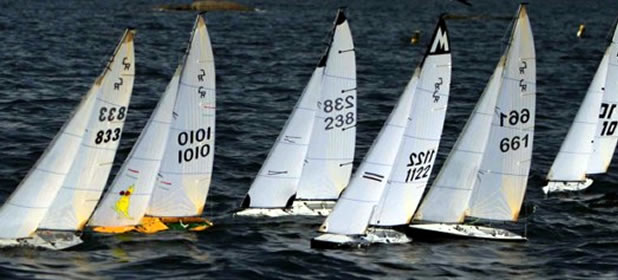
1/25 (36") Scale America's Cup high performance model sailboat
5ft Replica of the 1962 Americas Cup 12 Meter
45" Scale Model of the Olympic Star Boat
J Class Boat-Shamrock V
1/16 (8'-10')Scale Replica of the 1930's America's Cup Class Yacht
RMG Sail Winches
High Performance sail control winches

[Library/logo/wrappers/logo-wrapper.htm]
- Create as many news links as you need. News links are simple bullet lists.
This is where you would add your text, images, or advertising banner
CR-914 RADIO CONTROL MODEL SAILBOAT Easy to Build, Fun to Sail. No Better way to get Started
One of the hottest classes in the American Model Yachting Association (AMYA)
The CR-914 is a strict one design AMYA sanctioned 1:25 scale model based on the Americas Cup class yacht.
The kit comes with everything you need to build your boat. All you need are some simple tools, sandpaper, paint and batteries. Excellent sailing performance in a wide wind range. With quick acceleration and turning this boat will thrill and excite the expert as well as the novice.
CR-914 CLASS WEB SITE
| Cedar Point Marina August 19-20 |
View Kit Options Kit Accessories
BUILDERS TIPS AND TRICKS PAGE

Copyright © 2021. Chesapeake Performance Models LLC. All Rights Reserved..
RC Sailboat: T37 Racing Sloop
For accessories for the T37 RC Sailboat, including a varnish kit and stands, visit the T37 RC Sailboat Accessories page.
A Remote Control Sailboat that is fast, powerful, affordable, and fun to build. The T37 RC Racing Sloop is 37 inches long, 5 feet high, and has a total weight of 4 pounds with the keel ballast casting weighing 2 of these pounds. There are more than 3000 T37 RC Sailboats sailing today, some in countries as far away as Thailand and New Zealand! It is a fully sanctioned one design class in the American Model Yachting Association (AMYA).The T37 balances perfectly and sails fast. She tacks effortlessly and will sail in winds gusting up to 20 mph. As with all of our model sailboats, the heavy ballast casting at the bottom of the keel makes it impossible to tip the sailboat over. All fittings on this RC sailboat are solid brass or high grade marine 316 stainless steel. The hull is very light and strong, built from 1/8 inch mahogany plywood. The sails are genuine nylon spinnaker cloth; this is the same material that is used on full size sailboat spinnakers. The mast can be removed in less than one minute for easy transport.
For an even higher level of performance, speed, and maneuverability, the T37 Racing Sloop is also available in the Racing Upgrade version. Especially if you are considering racing your T37, the T37 Racing Upgrade Racing Sloop may be the best boat for you.
The T37 RC Sailboat Kits come with everything you will need to build the boat, including the marine epoxy and all of the RC gear (except for batteries) for sailing the boat. In fact, all you need is paint or varnish and AA batteries! For assembly, we recommend ages 15 and up, or 12 and up with an adult. For sailing and racing, we suggest ages 8 through adult.
The T37 RC Sailboat kit is quick to build (around 20 hours building time) and is a great introduction to using epoxy in boat building. No previous building experience is required. Very complete building videos on YouTube detail every step in the building process for the T37. The kit includes:
- Hull and deck pieces pre-cut to an accuracy of 1/1000 of an inch from the highest grade of marine Okume plywood
- High-quality brass and stainless steel hardware
- Spectra and monofilament rigging lines
- Carbon fiber mast and Hardwood booms (wooden mast available on request)
- ¾ oz. Nylon Spinnaker cloth pre-sewn sails
- Marine-grade epoxy, along with epoxy brushes and syringes
- Full Radio Control gear, including the transmitter, receiver, battery box, and rudder and sail servos
- Keel ballast casting
- Excellent, detailed building instructions to guide you through the entire building process
Each boat has a unique personality reflecting the builder's preference for paint styles and colors. The T37 is one of only a few Remote Control sailboats built out of wood, and one of the most elegant RC sailboat kits available. For most sailors, the T37 is an ideal model sailboat; powerful, seaworthy, fast, and just the right size. This RC sailboat will give pleasure for generations of sailors.
Sails can be made in any of the colors shown on the color swatch in the last picture. The standard main sail colors are white and fluorescent yellow, and the standard jib sail colors are white, dark blue, red, and fluorescent orange. Other colors listed are an additional $6.50 per sail. If you would like to choose a non-standard color, select "Other" from the drop-down menu and leave a comment in the "Add a note to your order" box during checkout.
For accessories for the T37 RC Sailboat, including a varnish kit and stands, visit the T37 RC Sailboat Accessories page.
Please call 1-360-966-7245 or email [email protected] to inquire about the availability and pricing of finished boats. The finished boat comes fully completed and ready to sail. Happy Sailing!
Related products
Tippecanoe Boats
RC Sailboat: T27 Racing Sloop
from $375.00
RC Sailboat: T37 RACING UPGRADE Racing Sloop
from $560.00
RC Boat: Stormy 45 Steam or Electric
from $655.00
T47 Radio Controlled Schooner
Our Types of Kits
Tippecanoe kits are fun and easy to build. In our world which is becoming increasingly virtual it is a great experience to build something real and tangible. The excitement of getting to sail your own boat when you have finished building is unparalleled! What could be more fun? The Tippecanoe boat you build tomorrow might well be in your family for generations to come. We design our boats to be beautiful, to sail fast, to be easy to build and to last for years and years.
Free-Sailing Sailboat Kits
All of the woodworking is already completed when you receive your free sailing kit. The sails are pre-sewn and the hull is already sanded, ready for varnish. The building instructions are very clear and easy to follow.
Everything you need to build the kit is included except for paint or varnish. The T12 and the T15 include racing stripes that can be applied to the hull for an extra decorativie accent. Assembly time after varnishing is about 25 minutes for the T12 Cruiser, 30 minutes for the T15 Racing Sloop, and 45 minutes for the T18 T-Class. All of the boats are also available finished and ready to sail.
Radio-Controlled (RC) Sailboat Kits
Tippecanoe RC boats are sophisticated and fast – and easy to build! Every kit includes everything you need to build and sail your Tippecanoe radio controlled sailboat except for paint, varnish and AA batteries. All of the radio control gear, including the handheld transmitter as well as the in-boat reciever, is included in the kit. The radio control gear is all full power rc hobby gear. The instructions are written clearly in non-translated English and are based on the assumption that you are an aero-space engineer that needs very little help – no, actually I write all of the instructions with the assumption that you have never done anything even vaguely similar to building a boat before in your life and every detail of every step is explained very carefully. After all, before long, you will have your beautiful boat at the lake and lots of people will be admiring it and asking if it was hard to build. When owners tell others how fun and easy the boat was to build and how clear the instructions are – well, this is why there are so many Tippecanoe boats in the world today.
We currently have over 65,000 Tippecanoe boats sailing in more than 60 countries around the world. We do everything possible to make building your Tippecanoe boat as fun and as rewarding a project as possible. You can call us anytime and talk with Will, the designer of the boat you are building if you have any questions or want to share an update on how your boat is progressing. Spare parts are always available upon request and all of our kits are made right here in the US.
The wooden parts in our RC kits are pre-cut with a precision computer controlled router. The boats are assembled with a West System marine epoxy, the same as is used on full sized boats. All of the epoxy is included in the kits. We include a clear version and a pre-thickened version of the epoxy. The pre-thickened version spreads just like mayonnaise with no sag and no running so it is remarkably easy to use. The epoxy is super strong, so your boat will last for years and sail beautifully even if you only get a small amount of the epoxy in the right places! The differences we see between boats that different owners have built is only how carefully the final finishing is done. All of the boats are beautiful, all of the boats sail beautifully and all of the boats will last for many, many years. Every boat is finished off differently with different colors and different design ideas so every boat becomes a very personal creation with its own special character. Go wild, build a boat! Have fun building and sail a boat that you have built!
Copyright All Rights Reserved

Return to RC Sailboats
RC Sailboat – Getting Started

RC Sailboat in Calm Wind – This is relaxing, but when that wind picks up….
An RC Sailboat (RC – Radio Control) as you may or may not expect, uses the exact same controls as a full size sailboat. If you’ve been lucky enough to pilot a full size sailboat, then you should have no problem with an RC Sailboat.
One of the unique characteristics of an RC Sailboat is it’s one of the few RC’s that operate using renewable energy for its main power source. This means you don’t need large, expensive batteries or gasoline to power it.
If you are completely new to RC Sailing, it is recommended to read through some of the terms at the bottom of the page, or if you are looking for a quick refresher. Once that is out of the way, we can look at the different options available in order to get hooked. Or what we mean here is more involved, you get the idea.
Depending on either how much time you may have or your building skills may determine how you get more involved with RC Sailboats. First we will consider the easiest way to get in to the hobby.
There are many RTR (Ready to Run) RC Sailboat s available that makes it a very easy transition in to the hobby. Typically RTR includes everything you would need to start sailing except for maybe some disposable batteries. AA are the most common.
The boats are classed most commonly by Length where the general rule for RC Sailboats is they come in lengths less than 30 inches, a length of one meter, and larger lengths up to 2 meters. Due to being an all around performer the One meter class is the most popular, largely from the ability to perform very well on the water and look awesome from land. It is also large enough to see as you sail it 50-100 feet away.

RC Sailboat – Vela One from Aquacraft
The number one recommended RC Sailboat for someone new to the hobby yet desiring one that is both competitive, RTR and a larger size, being in the one meter class, for ease of visibility is most definitely the Aquacraft Vela One. This hull performs well, is super easy to get sailing and is large enough to sail from a good distance. Expect this hull to excel.
40″ Hull Length and a 79″ Mast Height, Wow! All control system components come included in the 2.4 GHz System.
If you desire a less expensive high performing hull the perfect beginner Sailboat is the Aquacraft Paradise Sailboat. This boat will teach you the basic skills of sailing your own boat and perfecting the skills to become profecient in sailing. The hull length is 26″ and the mast height is 50.” At this size, it is quite visible at close to medium distances away from the sailor. All radio equipment comes include with this RC Sailboat with very little Setup required to start sailing.

Aquacraft Paradise Sailboat
Common Parts of an RC Sailboat
There are 7 common components that are found on nearly all RC Sailboats. The 7 common parts consist of the hull, mainsail, mast, boom, jib, keel and rudder. The hull is the main structure of the boat that contains all the other parts within it. Typically found in the center of an RC Sailboat on the under side of the hull is the keel. The keel is responsible for holding the hull straight during forward motion. The difference between a full size boat and our RC Sailboat is that the keel you would find on an RC Sailboat contains a weighted bulb at the very bottom that assists in stabilizing the hull under heavy wind conditions. The mast is located relatively close to the center of the hull and points directly up from the boat. The boom is positioned 90 degrees from the mast and helps support the mainsail which is attached to the boom and the mast. The mainsail is responsible for capturing the majority of the wind energy to propel the boat forward whereas the jib is a smaller sail commonly near the front of the boat that serves the purpose of capturing extra power to propel the hull forward.

RC Sailboat – Common Parts
How an RC Sailboat works
An RC Sailboat works by either capturing or redirecting wind energy to propel the boat forward. This is accomplished by the Sailor of the boat placing the sail in the proper direction to catch the wind and at the same time providing a constant heading for the boat to travel in. Steering on the hull is accomplished by controlling the rudder. An input signal on the radio is sent to the Sailboat and this is converted into motion that operates the rudder. The Sailboat controls are powered by a small battery that only operates the control system. This is better explained in the RC Sailboat controls page and also the how to Sail page. (coming Soon)
Radio Control Info Articles
- 3D Printing (2)
- General Electric (44)
- General Radio Control (13)
- Patreon Posts (107)
- RC Airplanes (6)
- RC Boat (3)
- RC Cars/Trucks (19)
Recent Articles
- RC Calc Sheet V24.09 Released September 5, 2024
- RC Battery Sheet V24.09 Released – SMC Battery Added September 5, 2024
- Video will be live in about 80 minutes August 27, 2024

Occasional ruminations, experimentations, and observations on the art and nonsense of building wooden radio control sailboats. Thanks for visiting!
Search This Blog
R/c sailboat builds.
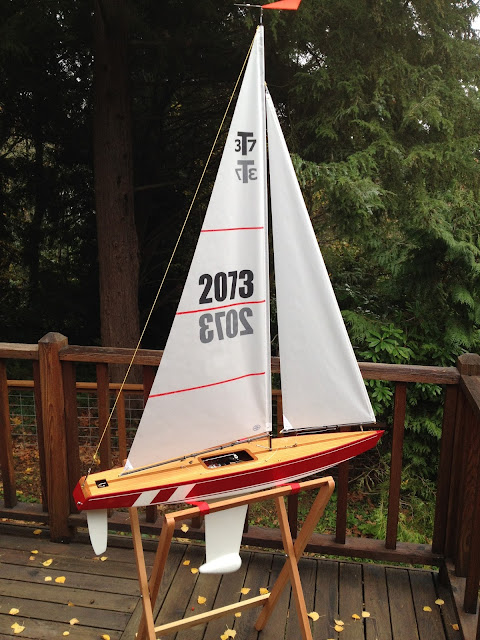
The "Salish" boat is fantastic. I have been looking into building a T-37 (which is how I found your blog), but it is hard to look beyond the bottom of the blue boat.
Thanks Chance! Good luck on whatever you end up building.
Post a Comment
Popular posts from this blog, iom sailboat stand, iom rig box (iom sail box) plans, iom alignment and measuring jig (updated), a wooden "alternative" iom rc sailboat.

Exploring the World of 1m RC Sailboats: The Ultimate Guide
- By - Kyle Hilson
- Posted on November 14, 2023 November 15, 2023
- Posted in RC Boats
1m RC sailboats have become increasingly popular among hobbyists and enthusiasts in recent years. With their miniature size and intricate designs, they offer both recreational and competitive sailing opportunities. These remote-controlled boats have become a favorite for people who love to build and race their own boats. The boats come in various sizes and designs, but the 1m RC sailboat is one of the most popular sizes. It is small enough to be easy to transport and launch, yet large enough to showcase impressive sailing skills. The design of these boats allows sailors to enjoy the thrill of the wind in their sails and the joy of seeing their own creation out on the water. With technology that continues to advance, these remote-controlled sailboats have become even more sophisticated, allowing for enhanced control and maneuverability. Whether you are a beginner or an experienced sailor, building and sailing a 1m RC sailboat is a rewarding experience that offers hours of entertainment and enjoyment. In this article, we’ll explore all there is to know about 1m RC sailboats, from building and sailing to locations and regulations.
What is a 1m RC sailboat?
A 1m RC sailboat is a remote-controlled miniature boat that can be sailed in ponds, lakes, and other calm bodies of water . These boats are designed to be self-righting and can sail in light wind conditions . They usually consist of a plastic hull and a rigging system that includes a mast , sails , and ropes . Here are some additional details about 1m RC sailboats:
- The standard size for a 1m RC sailboat is around 39 inches in length and 75 inches in height .
- The hull is usually made of lightweight plastic , such as ABS plastic or fiberglass , to make it easy to transport and maneuver.
- The self-righting feature allows the boat to recover from capsizing due to wind or waves.
- The weight of the boat is usually around 6-7 lbs to ensure it is lightweight and easy to transport.
- There are different types of rigging styles , such as Bermuda , Gaff , and Lateen rigging , each with their own advantages and disadvantages.
- Fully-functional 1m RC sailboat kits are available for purchase online, with detailed instructions to help you build your own sailboat at home.
Building and owning a 1m RC sailboat can be a fulfilling hobby. If you’re looking for more information on building your own sailboat, websites such as modelboatmayhem.co.uk and rcgroups.com offer a wealth of information on the subject. In addition, you can purchase pre-built 1m RC sailboats at hobby and toy stores or online retailers such as Amazon and Tower Hobbies.
How do remote control sailboats work?
Remote control sailboats work by using a radio transmitter and receiver. The radio transmitter allows the user to control the boat’s movements from a distance. On the boat, the radio receiver is connected to two battery-powered electric motors or servos which change the position of the boat’s sails or rudder. To control the boat’s speed or direction, the user sends signals to the transmitter which are then interpreted by the receiver and translated into instructions to change the position of the servos.
Benefits of Owning a 1m RC Sailboat
There are numerous benefits to owning and sailing a 1m RC sailboat . Here are some of the most notable:
- Cost-effective : 1m RC sailboats are relatively inexpensive to maintain. Other than occasional battery replacements and minor repairs, they require little upkeep.
- Relaxing hobby : Sailing a 1m RC sailboat can be a stress-relieving form of recreation, allowing you to unwind and clear your mind.
- Sense of accomplishment : Building, customizing, and sailing your own boat can provide a sense of pride and accomplishment .
- Rich history : The history of model boats dates back thousands of years to ancient Egypt, with model boats sometimes serving a ceremonial or religious purpose.
- Community : Clubs and organizations exist worldwide for remote-controlled boating enthusiasts to connect and share their passion.
- Customizable : 1m RC sailboats can be customized with different sails, rigging, and decorations according to personal preferences.
If you’re interested in trying out this fun and fulfilling hobby, consider joining a local remote-controlled boating club or accessing online resources such as modellingtips.com, which offers comprehensive guides on building and maintaining 1m RC sailboats .
Here is a table comparing the cost of three popular 1m RC sailboats :
| Model | Cost | Features |
|---|---|---|
| $69.99 | Waterproof design, compact size | |
| $329.99 | Low drag keel design, highly responsive rudder | |
| $319.99 | Easy to assemble, adjustable rigging |
What are the benefits of owning a sailboat?
Owning a sailboat has several benefits. One of them is its ability to take you anywhere, making it the ideal craft for traveling long distances. Not to mention, you can save a lot of money on airfare and hotel accommodations. Another benefit is that a sailboat’s engine is much smaller and is used far less compared to a powerboat, which keeps maintenance and fuel costs down.
Different Types of 1m RC Sailboats
There are a variety of different types of 1m RC sailboats available, each with unique features and purposes. Some of the most common types of 1m RC sailboats include:
- Racing boats: Designed for speed and maneuverability, racing boats typically have a sleek, aerodynamic design and a narrow keel. They are built to compete on flat, calm waters and can reach speeds of up to 20 mph.
- Cruising boats: These boats are designed for leisurely sailing and generally have a wider hull and deeper keel than racing boats. They are built for stability and can handle a wider range of water conditions.
- Scale boats: These boats are built to replicate full-size boats and can be highly detailed and intricate. They come in a variety of styles, including historic boats, modern sailboats, and luxury yachts.
- Classic boats: These 1m RC sailboats are designed to resemble boats from the 1930s or earlier. They are typically made of wood and have a timeless, elegant design.
- Solar-powered boats: A newer option in the RC sailboat world, these boats utilize solar panels to power the electric motor. They are environmentally friendly and quiet, making them a popular choice among eco-conscious hobbyists.
Depending on your interests and preferences, one type of 1m RC sailboat may be more suitable than others. To learn more about the different types of 1m RC sailboats , check out websites like sailboats.co.uk or myhobbyhouse.com , which offer a wide selection of boats and resources for remote-controlled boating enthusiasts.
What are those racing boats called?
Racing boats, also known as shells, are long and narrow watercrafts that are semi-circular in cross-section to minimize drag. To increase the effectiveness of the rudder and prevent roll and yaw, they have a fin towards the rear. You can find more information about racing shells on Wikipedia.
Building Your Own 1m RC Sailboat
Building your own 1m RC sailboat is a great way to dive deeper into the hobby and gain a deeper appreciation for the craftsmanship and engineering that goes into building and operating these boats. Here are some tips to help you build your own 1m RC sailboat :
- Decide on the type of boat you want to build and select a set of plans or a kit that meets your needs. There are plenty of resources available online, including websites like modelerscentral.com and modelshipworld.com, that offer kits and supplies for model boat building.
- Choose the materials for your boat. Different boats may require different materials, but common options include wood , plastic , fiberglass , and aluminum . Make sure to select materials that are strong, lightweight, and easy to work with.
- Use appropriate tools to build the boat. Depending on the materials you are using, you may need tools like saws , sandpaper , drills , and glue . Make sure your workspace is clean and well-lit, and take your time to ensure precision and accuracy in your work.
- Assemble the parts of the boat. This may involve fitting together pieces of the hull, crafting masts and sails, and attaching rigging lines. Follow the instructions carefully and be patient, as some of these steps may require a steady hand and attention to detail.
- Add the finishing touches. Once the boat is assembled, you may want to paint or decorate it, add extra details like flags or deck furniture , and test it in the water to ensure that it sails smoothly and safely.
If you’re new to model boat building or need some guidance on building a 1m RC sailboat , there are a number of resources available online to help you get started. Websites like modelboatmayhem.co.uk and modelboatbuilder.co.uk offer forums and communities for enthusiasts to share tips and advice, and YouTube channels like How To Build A Model Ship offer step-by-step tutorials and inspiration for your next project.
What do you need to build a model ship?
To build a model ship, you will need a few essential tools such as a compass, ruler, calculator, hand-drill, fretsaw with table and clamp, sanding materials, needle files, and wood rasps. These tools are necessary for measuring, cutting, drilling, shaping and sanding the various parts of the ship. If you’re looking for these tools, you can check out websites like Modelers Central and Model Expo, which offer a wide variety of model ship-building tools and kits.
Best Locations for Sailing Your 1m RC Sailboat
Once you’ve built your 1m RC sailboat , you’ll want to find a great location to put it into the water and enjoy it to the fullest. Here are some of the best locations for sailing your 1m RC sailboat :
- Ponds : Small ponds can be a great option for sailing your 1m RC sailboat , as they often offer calm waters and plenty of room to sail without causing any disturbance.
- Lakes : Larger, deeper lakes can provide plenty of opportunities for long-distance sailing and exploration. Just make sure to avoid crowded areas where other boaters or swimmers may be present.
- Rivers : Slow-moving rivers can be ideal for sailing, as they generally offer calm waters and plenty of room to maneuver. Be sure to be aware of any currents or obstacles in the water.
- Oceans : If you’re ready for a bigger challenge, consider taking your 1m RC sailboat out into the ocean. Just make sure to choose a calm day with good weather conditions, and be aware of any tides or currents that may affect your boat’s navigation.
It’s important to remember that wherever you choose to sail your 1m RC sailboat , you should always follow local boating laws and regulations to ensure safety and good stewardship of the waterways. You may also want to consider joining a local boating club or community, where you can share your passion for model boats with other enthusiasts and enjoy organized sailing events.
Some great resources for finding local sailing clubs and events include websites like rcgroups.com and offshoreradiosail.org. Additionally, many hardware and hobby stores that sell 1m RC sailboats may also offer workshops or classes on sailing and maintenance, so be sure to check with your local retailer to see what resources are available.
What are the best conditions for sailing?
The most comfortable sailing is in winds from 5 to 12 knots. When the wind is below 5 knots, maneuvering and powering the boat with the sails can become difficult. For more information on sailing, check out websites like Sail Magazine or products like The Complete Sailing Manual by Steve Sleight.
In conclusion, 1m RC sailboats can be a wonderful hobby for those who love sailing and enjoy tinkering with models. They offer a low-cost, low-maintenance way to experience the thrill of the water and impress your friends with your skills. Whether you’re interested in racing, cruising, or just exploring the waterways, there’s a 1m RC sailboat out there that’s perfect for you.
Remember, building and sailing a 1m RC sailboat is a great way to relieve stress, learn new skills, and enjoy the outdoors. With the right materials, tools, and resources, anyone can build a beautiful and high-performing sailboat that will provide hours of enjoyment on the water.
If you’re ready to get started, be sure to review our guide to building a 1m RC sailboat and explore some of the great resources available online or through your local hardware and hobby stores. With a little patience, creativity, and persistence, you can soon be enjoying the satisfaction of sailing on the water with a boat that you built with your own two hands. So what are you waiting for? Get out there and start sailing!

Previous Article
Next article.


COMMENTS
Step 1: Components. Below is a list of the material used to construct the RC sailboat, most of the items can be sourced on Amazon or a hobby website like Hobby King. Electronic Components. Qty. 1 - Arduino Uno. Qty. 1 - Arduino Nano. Qty. 1 set - RF Transceivers.
RC sport sail. Most kits and RTR (ready-to-run) model RC sail boats are best categorized as RC sport scale. This category is a happy medium between full-blown scale models and RC racing yachts. Some have become so widely distributed that new racing classes has been formed around them. Good examples are Graupner's Micro Magic and Kyosho's Fairwind.
Here I describe with photos how I built the radio-controlled RC sloop Emma, a 1meter long, 6kg model boat. Plans with instructions are available online from...
Overcoming Challenges in RC Sailboat Kits. Building and sailing radio-controlled sailboats can present some challenges, especially for beginners.One of the biggest challenges is understanding the complex instructions. Moreover, setting up the radio transmitter can also be daunting as it requires technical skills. Additionally, navigating the boat can be difficult as the wind and water ...
Consider a Kit Boat: Consider a kit boat. There are a few out there. A very popular wooden kit boat is the Tippecanoe T37. It's a wonderful kit that includes everything including the radio equipment. My first wooden RC boat was a T37 and I would never have gone on to build other boats without being "kick started" by it.
One day build of an RC Sailboat designed to race in the 2017 PBC Annual Yacht Race.A link to a PDF of all the materials is herehttps://drive.google.com/file/...
The official body overseeing RC sailboat racing internationally is the International Radio Sailing Association. Once you get into it, racing provides a set of rigorous rules to sail by. There are specific classes of racing boats, generally denoted by a short letter/number combination. For example, the EC R12M class is found predominantly in the ...
An easy-to-build, eye-catching, high-performance sailboat. Who hasn't dreamed of a little wooden sailboat with a beautiful canvas cover? The idea for this project is a child's dream. Sailing on a regular basis in "scale 1", we had the idea of having fun by sailing two boats to race in our "spare time".
This is my manual on how to build a classic, wooden, radio-controlled sailboat using purchased laser-cut frames. It's 128 pages, and includes almost 200 images and drawings. The latest version is 1.4 and covers how I made my own cast-lead ballasts. The boats shown in this manual are Vintage Marblehead's that have been updated for RC, but the ...
An in depth look at the original Bearospace RC sailboats. Semi-scale sailing models with the character of traditional vintage boats from days gone by. Design...
Moving forward in a straight line. First, the basic skills. With the boat in the water, start with the wind half way between the front (bow) of the boat, and the side (beam). Keeping the rudder straight, trim (move) the sails so that they are close to the hull (close hauled) and the boat should move forward.
Step 3: Cutting the Pieces. Resize the .PDF as you wish for making a bigger or smaller boat. This model is 900mm long. Tip: Under 550mm boats built with this plans tend to submerge when the lake is choppy. Be careful! Print the pieces in white paper sheets and stick them on the 3mm panel. Draw the contour of the pieces with a pencil into the ...
The CR-914 is a strict one design AMYA sanctioned 1:25 scale model based on the Americas Cup class yacht. The kit comes with everything you need to build your boat. All you need are some simple tools, sandpaper, paint and batteries. Excellent sailing performance in a wide wind range. With quick acceleration and turning this boat will thrill and ...
PlaySTEM Voyager 400 Motor-Powered RC Sailboat (Blue) w/2.4GHz Transmitter. 1 review. $449.99. Add to Cart. Kyosho Seawind ReadySet Racing Yacht w/KT-431S 2.4GHz Radio. Not yet reviewed. $249.99. View Details. Kyosho Fortune 612 III RTR Electric Sail Boat w/KT-431S 2.4GHz Radio.
Building an RC boat from a kit can be an excellent way to start with RC hobbies, particularly for beginners.Assembling an RC boat from a kit provides a better understanding of every component and how they all come together to make the boat work.. RC boat kits range from basic to highly complex kits with detailed instructions.; They contain all the necessary components for assembly, including ...
Sailing yacht rc model construction process: engineering, hull and structures, part 1 of 3. In this video we'll see the realization of a realistic sailboat m...
White. Quantity. $465.00 USD. For accessories for the T37 RC Sailboat, including a varnish kit and stands, visit the T37 RC Sailboat Accessories page. A Remote Control Sailboat that is fast, powerful, affordable, and fun to build. The T37 RC Racing Sloop is 37 inches long, 5 feet high, and has a total weight of 4 pounds with the keel ballast ...
Tippecanoe RC boats are sophisticated and fast - and easy to build! Every kit includes everything you need to build and sail your Tippecanoe radio controlled sailboat except for paint, varnish and AA batteries. All of the radio control gear, including the handheld transmitter as well as the in-boat reciever, is included in the kit.
Radio Controlled Sailboats are miniature sailboats that are operated by a remote control device. They are popularly referred to as "RC Sailboats" by enthusiasts and hobbyists. RC sailboats are more than just toys or collectibles. They require a certain level of skill, strategy, and dedication to use efficiently and effectively.
this is a video that shows you some of the basics to build a sail for a modellboat.if you are interested in more information or tips and tricks let me know!b...
There are 7 common components that are found on nearly all RC Sailboats. The 7 common parts consist of the hull, mainsail, mast, boom, jib, keel and rudder. The hull is the main structure of the boat that contains all the other parts within it. Typically found in the center of an RC Sailboat on the under side of the hull is the keel.
R/C Sailboat Builds. 1. A Tippecanoe T37. These are kits available from Tippecanoe Boats in Washington State. 2. A classic, wooden, Star 45. It has been officially measured and is class legal. The Star 45 is a pretty, classy, builders boat that has withstood the test of time. 3.
Remember, building and sailing a 1m RC sailboat is a great way to relieve stress, learn new skills, and enjoy the outdoors. With the right materials, tools, and resources, anyone can build a beautiful and high-performing sailboat that will provide hours of enjoyment on the water.